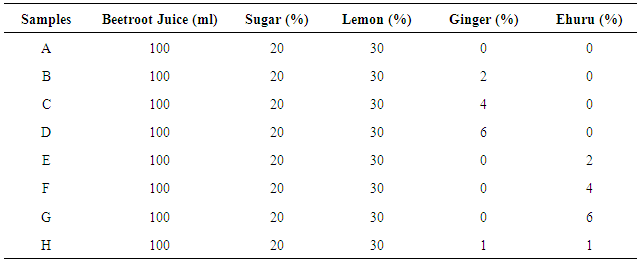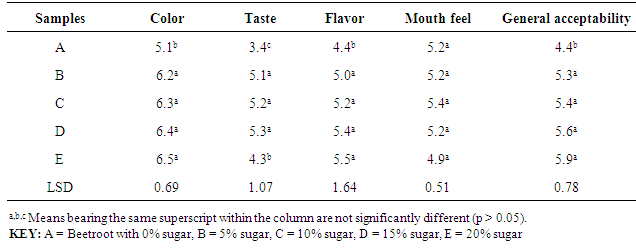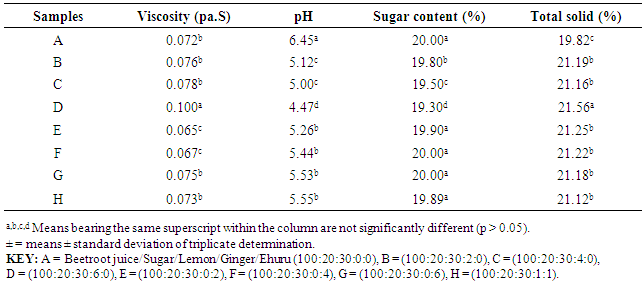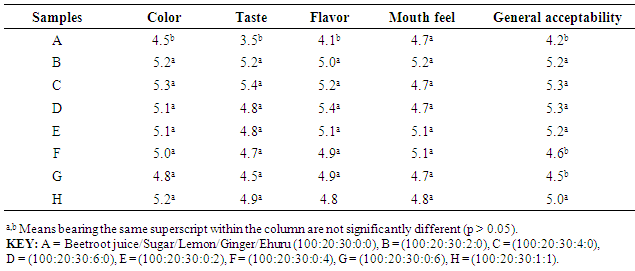-
Paper Information
- Paper Submission
-
Journal Information
- About This Journal
- Editorial Board
- Current Issue
- Archive
- Author Guidelines
- Contact Us
International Journal of Food Science and Nutrition Engineering
p-ISSN: 2166-5168 e-ISSN: 2166-5192
2016; 6(1): 14-19
doi:10.5923/j.food.20160601.03

Quality Characteristics of Beetroot Juice Treated with Indigenous Spices (Lemon, Ginger and Ehuru)
Emelike N. J. T., Barber L. I., Ebere C. O.
Department of Food Science and Technology, Rivers State University of Science and Technology, Port Harcourt, Nigeria
Correspondence to: Ebere C. O., Department of Food Science and Technology, Rivers State University of Science and Technology, Port Harcourt, Nigeria.
| Email: |  |
Copyright © 2016 Scientific & Academic Publishing. All Rights Reserved.
This work is licensed under the Creative Commons Attribution International License (CC BY).
http://creativecommons.org/licenses/by/4.0/

Beetroot (Beta vulgaris) tubers were processed into juice and treated with 0, 5, 10, 15 and 20% sugar syrup and pasteurized at 85°C for 10min to determine the level that will make a positive impact on the sensory attributes. The result showed that increasing levels of sugar syrup in the treated beetroot juices enhanced the sensory attribute of color; flavor and general acceptability up to 20% while sensory attribute of taste got to its peak at 15% sugar concentration and they were significantly higher than the control sample. Twenty percent (20%) sugar syrup was further used with lemon (30%), ginger (0, 2, 4 and 6%), ehuru (Mondora myristica) (0, 2, 4 and 6%) and a blend of ginger and ehuru (1:1) in the treatment of beetroot juice samples labelled A – H to study the effect of these treatments on the physical and sensory properties. The result showed that viscosity ranged between 0.065 – 0.100pa.S (E and D samples), pH 4.47 – 6.45 for samples D and A, sugar content 19.30 – 20.00% (D and multiples of A, F and G samples), total solid 19.82 – 21.65% for A and D samples, respectively. Sensory result of beetroot juice samples treated with indigenous spices showed that 4% ginger and 2% “ehuru” successfully improved all the sensory attributes more than the control sample.
Keywords: Beetroot juice, Indigenous spices, Quality characteristics
Cite this paper: Emelike N. J. T., Barber L. I., Ebere C. O., Quality Characteristics of Beetroot Juice Treated with Indigenous Spices (Lemon, Ginger and Ehuru), International Journal of Food Science and Nutrition Engineering, Vol. 6 No. 1, 2016, pp. 14-19. doi: 10.5923/j.food.20160601.03.
Article Outline
1. Introduction
- Every fruit has its distinct properties and characteristics such as physical, nutritional, functional and chemical benefits which play important roles in the body, such as regulation/maintenance of blood pressure and adequate digestion of food. Regular consumption of beetroot juice improves blood circulation due to its high iron content; it boosts the immune system, protects the liver and the bile duct [1]. Beetroot (Beta vulgaris) known as garden, table or red beets or informally called beets is a fruit that is well consumed in developing countries. Eastern Europe chops and made it into soups while Indians prefers it cooked and spiced [2]. Beetroot can be fermented into wine [3], but in recent trends, it is processed into readily digestible juices using different drying techniques to compare its sensory, physicochemical and minerals properties [4], as well as a flavoring agent to enhance the color of soy/carrot juices [5].Beetroot can be classified based on the plant parts and their uses into two categories [6]. Leaf beets (Beta vulgaris spp. vulgaris convar. circla) and tuberous beets (Beta vulgaris spp. vulgaris convar. vulgaris). Its leaves, stalks and roots are edible [7]. Beetroot juice is rich in minerals and vitamins with lots of health benefits which includes lowering of blood pressure due to the effect of vitamins such as folic acid and some minerals present in the juice [1, 8]. During processing of beetroot juice, spices such as lemon, ginger and “ehuru” can be incorporated to improve the health benefits of the juice or as a preservative. Ginger (Zingiber officinale) is commonly used in the treatment of various types of stomach problems including motion sickness, morning sickness, upset stomach, gas, diarrhea, nausea caused by cancer treatment, nausea and vomiting after surgery [9], as well as loss of appetite. Other benefits of ginger consumption include pain relief from arthritis, cough, chest pain and lower back pain [10]. Ginger can also inhibit the growth of microbes when used as a treatment in the processed fruit juice [11]. It has been reported to have a bactericidal effect against Escherichia coli and Streptococcus [12]. Ehuru (Mondora myristica) is used as a stimulant; cure for headaches and its essential oil can be obtained from the leaves [13]. Ehuru have similar taste and flavor to that of nutmeg; it is used in stews, soups, cakes as seasoning and flavoring. Generally, spices are good for nutritional therapy in view of the common diseases in Nigeria [14]. Based on this, “zobo” extracted from Hibiscus sabdariffa calyx was treated using different percentages of spices such as “uziza”, “ehuru” and ginger [15]. Pineapple juice was also spiced with ginger and lime at different percentages, as well as pineapple, orange and paw-paw spiced with ginger [16].Therefore, the aim of this work is to prepare beetroot juice treated with some percentages of sugar, lemon, ginger and “ehuru”, then analyze the effect of treatment on the physical and sensory characteristics of the beetroot juices.
2. Materials and Method
2.1. Procurement of Raw Materials
- Matured fresh tubers of beetroot (Beta vulgaris), lemon, ginger (Zingiber officinale), “ehuru” (Monodora myristica) and sugar were purchased from the fruit garden market, D-Line, Port Harcourt. All reagents were obtained from the Department of Food Science and Technology, Rivers State University of Science and Technology, Port Harcourt, Nigeria.
2.2. Processing of Beetroot Juice
- Three kilograms (3kg) of beetroot tubers were sorted, washed, the skin scraped off, rewashed and weighed with the aid of digital electronic balance. The weight left after sorting, peeling and washing was 2.5kg. The tubers were sliced into 2 – 3mm thick, grated into mash for better juice extraction using Philips HR2000 blender for 10min. The mash obtained was subjected into juice extraction using 2:2 of mash to water. It was filtered with muslin cloth folded into 2, 4 and 8 layers, respectively, to obtain beetroot juice according to method of Emelike and Ebere [17] for the filtration of cashew apple juice.
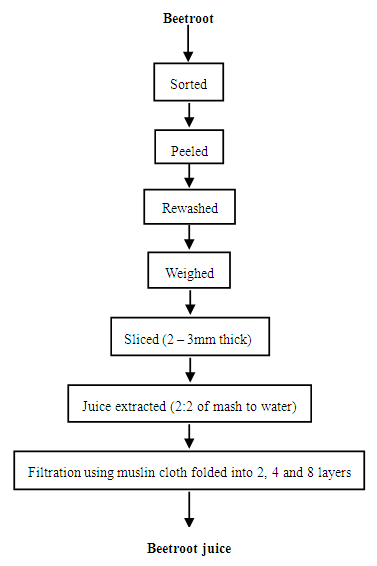 | Figure 1. Flow Chart for the Production of Beetroot Juice |
2.3. Processing of Lemon, Ginger, Ehuru and Sugar Syrup
- Lemon was sorted, washed and the juice extracted using juice extractor (IIoytron 23438, UK). Ginger was washed and scrapped to remove superficial skin, cut into small pieces of about 1 – 2mm thickness and mashed using Philips HR2000 blender for 10min. Water was added to prepare ginger juice with the blender in the ratio of 2:2 of ginger mash to water. The blend was then filtered through muslin cloth to remove fibers to obtain ginger juice. “Ehuru” water extract was obtained from dried granulated “ehuru” after soaking it overnight (12h) in 100ml of water. Sugar syrup was prepared by heating granulated sugar and water. Three hundred grams (300g) of sugar were dissolved in 150ml of water and heated at 97°C in a water bath for 7min. A golden brown gel sugar (caramel) formed was then used.
2.4. Treatment of Beetroot Juice with Sugar Syrup and Spices (Lemon, Ginger and “Ehuru”)
- To ascertain the percentage of sugar in the beetroot juice that will be accepted; 0%, 5, 10, 15 and 20% sugar syrup was used in the treatment of measured 100ml beetroot juice samples, consecutively. Preliminary test was conducted on the treated juice samples which showed that 20% sugar syrup effectively improved the organoleptic attribute of color, flavor, mouth feel and general acceptability. Therefore a conclusion was made to use 20% sugar syrup in the treatment of more beetroot juice samples in combination with other indigenous spices such as lemon, ginger and “ehuru”. Beetroot juice samples were then formulated by measuring 100ml of beetroot juices together with 20% sugar syrup and 30% lemon juice into eight (8) sterile bottles labelled A, B, C, D, E, F, G and H samples. Sample A was used as the control while samples B to H were further treated with ginger and “ehuru” percentages of 2:0, 4:0, 6:0, 0:2, 0:4, 0:6 and 1:1, respectively. All the samples were pasteurized at 85°C in a hot water bath (Techno Test, Italy) for 10min, cooled at room temperature and refrigerated at 5°C prior to analysis. Formulation of the beetroot juice samples are presented in Table 1 for better comprehension.
|
2.5. Physical Analysis of the Treated Juice Samples
2.5.1. Viscosity
- The viscosity of the treated beetroot juice samples was determined using a Rotary Digital Viscometer (NDJ-85, China) with spindle number 2 at 30rpm. Forty (40m1) of each juice sample were transferred into a sterile 40m1 beaker. The content of each beaker was introduced into the rotating spindle and the values of the juice viscosity displayed on the Liquid Crystal Display (LCD) screen in pa.S and were recorded.
2.5.2. pH
- The pH of the treated juice samples was determined using a digital pH meter (model PHs-2f, USA). The pH meter was calibrated using buffer solution at pH 4.0 and 7.0. Ten (10ml) of each juice sample was measured into a 10ml beaker. The electrode of the pH meter was placed into the beaker containing juice samples and the pH was read off on the LCD screen after sufficient time was allowed for stabilization.
2.5.3. Sugar
- The hand held sugar refractometer, ATAGO (0-32oBrix) was used for sugar determination. The prism of the refractometer was flushed with distilled water and dried. A drop each of the treated juice samples was placed on the prism and closed. The sugar content percentage (soluble sugar) was red from the scale of the refractometer when held close to the eye.
2.5.4. Total Solid
- The total solid content of the treated juice samples was determined using the air oven method. Aluminium dishes were washed; dried in the oven for 10min at 30°C and kept in the desiccator to cool, after which their weights were taken. Three grams (3g) of the treated juice samples were weighed into the dishes and the weight of the dish plus samples was taken. The dishes were placed in the oven for 1h at 105°C. The dishes were removed after cooling and total solid content was calculated.
2.6. Sensory Analysis
- Sensory analysis of the treated beetroot juice samples was carried out using a twenty member panel consisting of staff and students of Food Science and Technology Department, Rivers State University of Science and Technology, Port Harcourt, Nigeria. The sensory attributes evaluated were: Color/Appearance, Taste, Flavor, Mouth feel and General acceptability. The variously treated juice samples were served in clean glasses to individual panelist. The order of presentation of samples to the panelist was randomized. Potable water was provided for them to rinse their mouth between evaluations to avoid transfer of sensory attributes from one juice sample to the other. Each sensory attribute was scored on a 7 – point hedonic scale as described by Iwe [18], with 1 and 7 representing the least and the highest scores, respectively.
2.7. Statistical Analysis
- Results were expressed as mean values and standard deviation of three (3) determinations. Data were analysed using a one-way analysis of variance (ANOVA). Statistical Package for Social Science (SPSS) version 20.0 software 2011 was used to test the level of significance at 5% probability (p<0.05). Duncan New Multiple Range Test was used to separate the means where significant differences existed as described by the method of Wahua [19].
3. Results and Discussion
3.1. Sensory Properties of Beetroot Juice Samples Treated with Varying Levels of Sugar Syrup
- From the result, it was observed that increasing concentration of sugar level increased the color of the juice by 1% as shown in Table 2 and sugar is known to preserve color. The sensory score was highest (6.5) at 20% sugar level on a 7 – point hedonic scale. This is not far from 7.2 reported by Emelike et al., [4] for the color of the fresh beetroot juice with 20% sugar on a 9 – point scale. Sweetened beetroot juice scores also increased by 1% up to 15% sugar treatment in terms of taste. Sensory score for taste depreciate at 20% sugar concentration. This is an indication that the sweetness of beetroot juice got to its peak at 15% sugar treatment. Samples B, C and D had significantly higher taste to sample D and D to the control. Sugar syrup is a caramel with appealing flavor and the higher its concentration in a solution, the better the flavor. This is showed in this research as the flavor of the juice is observed to increase at increasing sugar concentration up to 20% leading to its better acceptance by the panelists. A significant difference was not recorded in all the samples in regards of mouth feel. This is not in line with the report of Banigo et al., [5] who observed a significant difference in all the juice samples produced from the blends of soy/carrot/beetroot. This could be as a result of different blends of juices as opposed to this research. In terms of general acceptability, the control sample had significantly poorer (p>0.05) score than juices with sugar treatment. Banigo et al., [5] reported beetroot juice to have great sensory attribute. This was evident as 10% beetroot juice was used to improve the sensory parameters of soy/carrot juice blends. Besides the earthly sensory attributes of beetroot juice, up to 20% sugar can be incorporated to enhance its color; flavor and general acceptability while its better taste can be achieved using 15% sugar concentration. Chaudhari and Nikam [20] reported that beetroot jelly with highest sugar level were better to other samples in terms of the sensory attributes.
|
3.2. Physical Properties of Beetroot Juice Treated with Sugar, Lemon, Ginger and “Ehuru”
- Analysis of the physical properties of the treated beetroot juice samples, indicated that sample D with 6% ginger had significantly higher (p<0.05) viscosity of 0.100pa.S as shown in Table 3. Ginger and ehuru treatments on samples B, C, G and H rendered no significant effect on the viscosity of the treated beetroot juices compared to the control sample. Samples E and F had a significantly lower viscosity (0.065pa.S and 0.067pa.S, respectively) compared to other samples. Increasing levels of ginger reduced the pH value of the beetroot juice towards acidity, while pH values of those treated with ehuru increased towards basic. Sample E with 6% ginger treatment had significantly lower pH of 4.47 and sample A the highest pH of 6.45. Beetroot has been reported to be an alkaline food with a pH range of 7.5 to 8.0 [21]. Emelike et al., [4] stated that fresh beetroot juice is slightly alkaline with a pH value of 7.1. Nwachukwu and Ezejiaku [22] also reported a reduced pH value of pineapple juice treated with garlic and ginger towards acidity. pH is an index for determining food quality, especially during storage. The more acidic juice is, the less susceptible to bacterial action [23]. According to the literature, ginger has the ability to inhibit the growth of microbes when used in the treatment of processed fruit juices [11]. The report of Dennies et al., [24], showed that garlic and ginger were effective in extending the shelf life of homemade sour-sop fruit juice during storage. Though shelf stability of the treated beetroot juice samples were not studied, the pH value reported here showed that 6% ginger can be used as a treatment to extend the juice’s shelf-life. “Ehuru” can be used to preserve beetroot juice to some extent since the juice treated with ehuru had a pH range of 5.26 to 5.53 (2 and 6% ehuru), respectively. Atlas [25] reported that most bacteria grow well over a pH range of 6 – 9. A significant increase or decrease was not observed in the sugar content of the beetroot juice treated with ehuru, ginger and ehuru blend (sample H) compared to the control sample. Significant difference (p>0.05) was not recorded in all the samples for total solids except sample A (19.82%) and D (21.56%) with significantly lower and higher total solid, respectively. Generally, sample D with 6% ginger treatment was found effective to improve the viscosity and total solid of the beetroot juice and decrease the pH value. This is evident that 30% lemon and 6% ginger could be used as treatment to extend the shelf life of beetroot juice as juices get more acidic at a reduce pH value. High acid foods have the tendency of preventing the growth of micro-organisms, thereby posed the advantage of being stored for a long time. Though, titratable acidity was not studied but Ndife et al., [26] observed a reversed case of a reduced pH leading to an increased acidity value. In comparison, ginger was found to impact more positively on the physical properties of beetroot juice than “ehuru”.
|
3.3. Sensory Properties of Beetroot Juice Treated with Sugar, Lemon, Ginger and “Ehuru”
- Sensory evaluation is a measure used to determine consumers’ acceptability of an existing, improved or newly developed products in the food and drink industries. The determination of consumers’ acceptability of products is usually based on the organoleptic characteristics such as color, taste, flavor, mouth feel and general acceptability. Fruit juices have been found to be more acceptable or more effective when two or more fruits are blended together to produce mixed fruit juice. Banigo et al., [5] studied the blends of soy/carrot/beetroot and reported that the three blends were better compared to other juice samples. The analysis showed that, beetroot juice treated with levels of ginger was significantly better (p<0.05) in all the organoleptic characteristics than juice without ginger treatment as presented in Table 4. Tandom et al., [27], equally stated that the blends of papaya pulp and bael pulp were effective in improving the appearance of the beverage. Gowda [28] reported the same trend in the case of mango and papaya blend. Increasing levels of ginger increased the panelists’ sensory scores for color and flavor while it was decreased by increasing levels of ehuru in the samples; although there were no significant differences. Aside the earthly color and flavor of beetroot juices, treatment with ginger, ehuru and ginger/ehuru blend significantly improved the sensory scores for color and flavor compared to the control sample. Emelike et al., [4] reported that the rating of the sensory attribute of flavor of beetroot juice samples between 6.2 and above on a 9 – point hedonic scale is an indication that beetroot has a great flavor. Grubben and Denton [2] equally reported beetroot as a flavoring agent. This result is similar to that reported by Bhardwaj and Mukherjee [29], that the overall organoleptic qualities were better in the juice blended in the ratio of kinnow juice: pomegranate juice: ginger juice (87:10:3) than the juices in the ratios of 87:10:0. Alais and Linden [30] stated that the skill in blending of spices in varying proportions will relate to other ingredient to enhance them. Nice [31] also stated that spices are aromatic flavoring added to foods and fruit juices to improve them, making them more attractive and palatable. There was no significant difference in the general acceptability of the treated beetroot juices between samples A (control), F and G. These three samples were significantly lower to other samples in terms of the general acceptability which ranged from 5.0 to 5.3 on a 7 – point hedonic scale. Through this research, ginger and “ehuru” spices have proven to improve the existing flavor and other attributes of beetroot juices.
|
4. Conclusions
- The result of the beetroot juices treated with varying levels of sugar syrup showed that up to 20% sugar syrup enhanced its color; flavor and general acceptability. Better taste was achieved at 15% sugar concentration besides the earthly sensory attributes of beetroot juice. Further treatment of beetroot juices with 20% sugar syrup, 30% lemon and varying levels of ginger, ehuru, ginger and ehuru blend showed that ginger impacted more positively on the physical properties of beetroot juice than “ehuru”. Sensory result showed that 4% ginger and 2% ehuru can be used as a treatment to improve the organoleptic attributes of the beetroot juice samples.
 Abstract
Abstract Reference
Reference Full-Text PDF
Full-Text PDF Full-text HTML
Full-text HTML